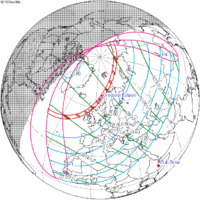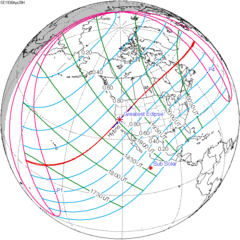| Total eclipse | |||||||||||||||||
 The Moon's hourly motion shown right to left The Moon's hourly motion shown right to left | |||||||||||||||||
| Date | April 22, 1921 | ||||||||||||||||
|---|---|---|---|---|---|---|---|---|---|---|---|---|---|---|---|---|---|
| Gamma | 0.4269 | ||||||||||||||||
| Magnitude | 1.0678 | ||||||||||||||||
| Saros cycle | 130 (29 of 72) | ||||||||||||||||
| Totality | 40 minutes, 7 seconds | ||||||||||||||||
| Partiality | 202 minutes, 2 seconds | ||||||||||||||||
| Penumbral | 331 minutes, 54 seconds | ||||||||||||||||
| |||||||||||||||||
| ← October 1920October 1921 → | |||||||||||||||||
A total lunar eclipse occurred at the Moon’s ascending node of orbit on Friday, April 22, 1921, with an umbral magnitude of 1.0678. A lunar eclipse occurs when the Moon moves into the Earth's shadow, causing the Moon to be darkened. A total lunar eclipse occurs when the Moon's near side entirely passes into the Earth's umbral shadow. Unlike a solar eclipse, which can only be viewed from a relatively small area of the world, a lunar eclipse may be viewed from anywhere on the night side of Earth. A total lunar eclipse can last up to nearly two hours, while a total solar eclipse lasts only a few minutes at any given place, because the Moon's shadow is smaller. Occurring only about 5.6 days after perigee (on April 16, 1921, at 16:10 UTC), the Moon's apparent diameter was larger.
This lunar eclipse was the third of an almost tetrad, with the others being on May 3, 1920 (total); October 27, 1920 (total); and October 16, 1921 (partial).
This was the first total lunar eclipse of Lunar Saros 130.
Visibility
The eclipse was completely visible over much of North America and western South America, seen rising over northeast Asia and Australia and setting over eastern South America, western Europe, and west Africa.
 
|
Eclipse details
Shown below is a table displaying details about this particular solar eclipse. It describes various parameters pertaining to this eclipse.
| Parameter | Value |
|---|---|
| Penumbral Magnitude | 2.08154 |
| Umbral Magnitude | 1.06782 |
| Gamma | 0.42693 |
| Sun Right Ascension | 01h57m53.3s |
| Sun Declination | +12°02'44.0" |
| Sun Semi-Diameter | 15'54.4" |
| Sun Equatorial Horizontal Parallax | 08.7" |
| Moon Right Ascension | 13h58m18.6s |
| Moon Declination | -11°38'56.5" |
| Moon Semi-Diameter | 15'41.5" |
| Moon Equatorial Horizontal Parallax | 0°57'35.3" |
| ΔT | 22.2 s |
Eclipse season
See also: Eclipse cycleThis eclipse is part of an eclipse season, a period, roughly every six months, when eclipses occur. Only two (or occasionally three) eclipse seasons occur each year, and each season lasts about 35 days and repeats just short of six months (173 days) later; thus two full eclipse seasons always occur each year. Either two or three eclipses happen each eclipse season. In the sequence below, each eclipse is separated by a fortnight.
| April 8 Descending node (new moon) |
April 22 Ascending node (full moon) |
|---|---|
 |

|
| Annular solar eclipse Solar Saros 118 |
Total lunar eclipse Lunar Saros 130 |
Related eclipses
Eclipses in 1921
- An annular solar eclipse on April 8.
- A total lunar eclipse on April 22.
- A total solar eclipse on October 1.
- A partial lunar eclipse on October 16.
Metonic
- Preceded by: Lunar eclipse of July 4, 1917
- Followed by: Lunar eclipse of February 8, 1925
Tzolkinex
- Preceded by: Lunar eclipse of March 12, 1914
- Followed by: Lunar eclipse of June 3, 1928
Half-Saros
- Preceded by: Solar eclipse of April 17, 1912
- Followed by: Solar eclipse of April 28, 1930
Tritos
- Preceded by: Lunar eclipse of May 24, 1910
- Followed by: Lunar eclipse of March 22, 1932
Lunar Saros 130
- Preceded by: Lunar eclipse of April 12, 1903
- Followed by: Lunar eclipse of May 3, 1939
Inex
- Preceded by: Lunar eclipse of May 11, 1892
- Followed by: Lunar eclipse of April 2, 1950
Triad
- Preceded by: Lunar eclipse of June 21, 1834
- Followed by: Lunar eclipse of February 21, 2008
Lunar eclipses of 1919–1922
| This section is empty. You can help by adding to it. (December 2024) |
Saros 130
Lunar saros series 130, repeating every 18 years and 11 days, has a total of 71 lunar eclipse events including 56 umbral lunar eclipses (42 partial lunar eclipses and 14 total lunar eclipses). Solar Saros 137 interleaves with this lunar saros with an event occurring every 9 years 5 days alternating between each saros series.
| Greatest | First | |||
|---|---|---|---|---|
 The greatest eclipse of the series will occur on 2029 Jun 26, lasting 102 minutes. |
Penumbral | Partial | Total | Central |
| 1416 Jun 10 | 1560 Sep 4 | 1921 Apr 22
|
1957 May 13
| |
| Last | ||||
| Central | Total | Partial | Penumbral | |
2083 Jul 29
|
2155 Sep 11 | 2552 May 10 | 2678 Jul 26 | |
| 1903 Apr 12 | 1921 Apr 22 | 1939 May 3 | |||

|

|

|

|

|

|
| 1957 May 13 | 1975 May 25 | 1993 Jun 4 | |||

|

|

|

|

|

|
| 2011 Jun 15 | 2029 Jun 26 | 2047 Jul 7 | |||

|

|

|

|

|

|
| 2065 Jul 17 | 2083 Jul 29 | ||||

|

|

|

| ||
Half-Saros cycle
A lunar eclipse will be preceded and followed by solar eclipses by 9 years and 5.5 days (a half saros). This lunar eclipse is related to two annular solar eclipses of Solar Saros 137.
| April 17, 1912 | April 28, 1930 |
|---|---|

|

|
See also
Notes
- "April 21–22, 1921 Total Lunar Eclipse (Blood Moon)". timeanddate. Retrieved 16 December 2024.
- "Moon Distances for London, United Kingdom, England". timeanddate. Retrieved 16 December 2024.
- "Total Lunar Eclipse of 1921 Apr 22" (PDF). NASA. Retrieved 16 December 2024.
- "Total Lunar Eclipse of 1921 Apr 22". EclipseWise.com. Retrieved 16 December 2024.
- Listing of Eclipses of cycle 130
- Mathematical Astronomy Morsels, Jean Meeus, p.110, Chapter 18, The half-saros
External links
- 1921 Apr 22 chart Eclipse Predictions by Fred Espenak, NASA/GSFC


